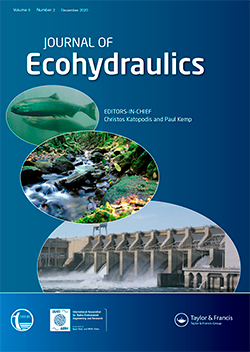Journal of Ecohydraulics | Vol. 7. Issue 2, 2022
The Journal of Ecohydraulics (JoE) is an international, peer reviewed journal, publishing high-quality, original research. It publishes varied research undertaken in ecohydraulics, covering water resources and aquatic life, ecology, biology, hydraulics, engineering, geoscience, environmental science, climate change, and other related fields, with an emphasis on the integration of these disciplines and the contributions they can make for a sustainable future.
IAHR members can access the latest issue online.
Overview
Following Vol.7 (1), the Journal of Ecohydraulics Vol.7 (2) presents the five papers of special issue “Organisms scale interaction with hydraulics conditions”, edited by guest editors, Heidi Nepf, Sara Ruijalon, and Herve Capra. Wide scales are treated from the scale of fish to that of the large wetlands of a Ramsar site. It is particularly noteworthy that although all these papers treat the restoration/conservation of ecosystems, they do not just explore the topic from an ecological standpoint as one might find in other ecological journals; in fact, this issue explores the engineering aspects, which are of vital importance for sustainable development. The following articles are presented.
Fishways are important facilities that protect the ecosystem of rivers.
One of the most important artificial phenomena related to conservation of the river ecosystem is connected to hydropower station water turbines, as they have a strong impact on the fish passing dams. So, designing a fish-friendly but efficient turbine is an important issue that has, until now, however, not been much discussed from both the engineering and biological perspectives. The first paper, “The bio-hill chart of a Kaplan turbine”, treats this issue. The paper shows engineering aspects as well as fish-related matters, a combination that is rarely found in other journals.
Water temperature significantly affects the migration of diadromous fish.
The second paper of this issue, “Assessing of cold-water refuges to reproductive migration corridor conditions for adult salmon and steelhead trout in the Columbia River, USA,” focuses on this phenomenon.
This study presents the results of the Columbia River for two Oncorhynchus species, including not only observed results but also theoretical considerations, thereby providing clues for understanding different types of migrating fish in different rivers. River managers in other countries, such as MLIT officers in Japan, will find this paper to be of great interest.
Flow structure is, without saying, an important factor in the design of fishways.
The simulated results of detailed flow structure are presented in the third paper of this issue, “Turbulent eddy identification of a meander and vertical-slot fishways in numerical models applying the IPOS framework”. Here, the amazing, simulated results around very complex fishway structures are shown. This method would seem to be possible in other areas, too. River managers involved in fishway allocation planning will find this paper to be very valuable in the selection of fishway types.
The coastal ecosystem is highly associated with the emergent plants that colonize the area.
They often contribute to erode the bed and affect the benthic ecosystem. Emergent plants are composed of above and belowground biomass, which contribute to bed erosion differently. The fourth paper, “Erosion protection by winter state of salt marsh protection,” presents experimental results and indicates their morphological characteristics. This paper will provide important information for not just the hydraulics researcher, but also the aquatic botanist.
The largest scale treated in this issue is the Abras de Mantequilla wetland in Equador. This wetland was declared a Ramsar site, due to its important role in the conservation of both birds and fish. This wetland shows distinctive wet and dry seasons, with a different hydrology for each period. The distribution of inundation levels was numerically simulated and presented clearly for these two seasons. The results provide important information for the restoration/conservation of the area as well. A similar methodology would be particularly important for other wetlands, too. This paper is extremely useful for wetland managers who are developing management plans.
Articles
The bio-hill chart of a Kaplan turbine
P. Romero-Gomez, M. Lang and S. Weissenberger
Pages: 94-110 | DOI: 10.1080/24705357.2020.1830723
Marcía N. Snyder, Nathan H. Schumaker, Jason B. Dunham, Matthew L. Keefer, Peter Leinenbach, Allen Brookes, John Palmer, Jennifer Wu, Druscilla Keenan and Joseph L. Ebersole
Pages: 111-123 | DOI: 10.1080/24705357.2020.1855086
Márcio S. Roth, Christian Jähnel, Jürgen Stamm and Lisa K. Schneider
Pages: 124-143 | DOI: 10.1080/24705357.2020.1869916
Erosion protection by winter state of salt marsh vegetation
Pages: 144-153 | DOI: 10.1080/24705357.2021.1938252
Gabriela Alvarez-Mieles, Enrique Galecio Valdes and Arthur E. Mynett
Pages: 154-175 | DOI:10.1080/24705357.2021.1938257
